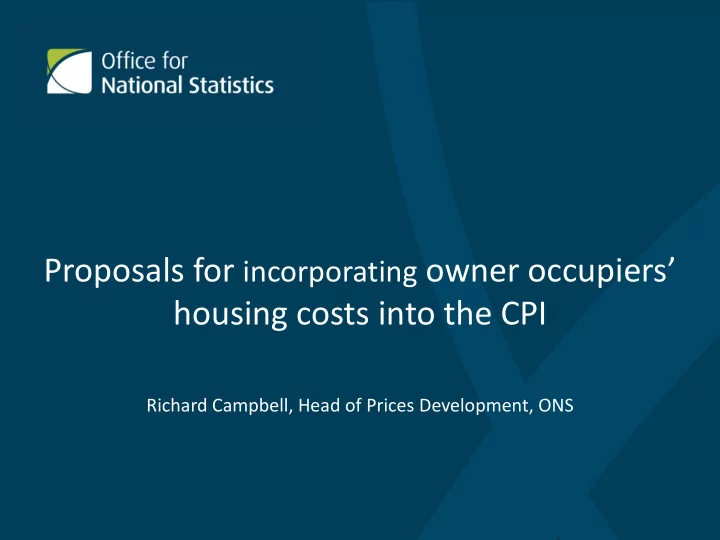

Proposals for incorporating owner occupiers’ housing costs into the CPI Richard Campbell, Head of Prices Development, ONS
Aim • Explain the options for incorporating owner occupiers’ housing costs into the CPI • Provide background and context for the current position • Get user input on implementation 2
Contents • Background – Context – History • The Methods – Rental Equivalence – Net Acquisitions – Comparison of the data • Next Steps 3
A quick point on terminology • OOH stands for owner occupiers’ housing costs • CPIH stands for ‘an expanded Consumer Prices Index incorporating owner occupiers’ housing costs CPIH = CPI + OOH 4
Background (Context)
Some possible examples of owner occupiers’ housing costs Stamp Duty Mortgage payments House prices Major repairs and maintenance Estate agents’ fees Dwellings insurance Home buyers’ surveys Surveyors’ fees 6
So why is measuring OOH so difficult? – The Theory • Housing is a very large purchase • Houses are a durable good (measure price at point of acquisition, payment or use) • Capital investment vs consumption expenditure • The purchase of a house is usually associated with some form of credit (e.g. a mortgage) requiring the repayment of principal and interest over a number of years 7
So why is measuring OOH so difficult? – The Practice • Lack of consensus on how to deal with the above issues • Lack of suitable data to measure OOH costs 8
Background (History)
History (1) - RPI 1956 - equivalent rents was introduced to the RPI as a measure of OOH costs 1974 - the RPIAC recommended that OOH costs should be represented in the index by mortgage interest payments, instead of equivalent rent 1986 - RPIAC re-affirmed the 1974 decisions 1994 - RPIAC recommended the introduction of a second component to go alongside mortgage interest payments, a ‘depreciation costs’ component, introduced to represent the ongoing costs homeowners face in maintaining the standard of their properties. 10
History(2) - HICP & OOH • Always the intention to incorporate OOH in HICP • Difficulties in agreeing approach meant it was initially excluded • Non-market goods and services in Consumer Price Indices – Peter Hill, 1997 gave impetus (no imputation so net acquisition appropriate option) • Methods been in development since • Stand-alone OOH net acquisitions index from Q3 2014 11
History (3) - OOH development with CPAC • Introduced OOH concepts at first meeting (June 2009) • Developed understanding with series of papers on methods and concepts (September 2009 to March 2010) • Ruled out two methods – Payments and Narrow User Cost (September 2010) • Publication of research to date and development programme in CPAC report to UK Statistics Authority (November 2010) • Rental Equivalence and Net Acquisitions methods further developed in line with programme (since November 2010) 12
Methods (Net Acquisitions)
Net Acquisitions - Overview • Net acquisitions aims to measure: – Changes to the price of a house – Changes in costs associated with buying a house – Changes in costs associated with maintaining a house • Exclude capital element of house purchase 14
Net Acquisitions – Summary of Data OOH Net Acquisitions Composition (2012 data) Component Description of Price Data Source of Expenditure Weight (all from National Accounts) House Prices (excluding land) DCLG (ONS from April Gross Fixed 2012) HPI Index Capital Formation (GFCF) Major Repairs & Renovations Developed using Household Final separate materials and Consumption services indices (HHFCE) & GFCF Transfer Costs Item indices from RPI HHFCE Stamp Duty Duty paid in each price GFCF band estimated using HPI for house sales Insurance connected with the Structural insurance price HHFCE Dwelling index from RPI Module 5 - OOH 15
Methods (Rental Equivalence)
Rental Equivalence - Overview • Treats the house as a capital good • The owner receives a ‘flow of services’ from the house: – shelter – security of tenure – ability to alter dwelling • ‘What would I have to pay if I rented my property on the private market?’ 17
Rental Equivalence – Summary of Data OOH Rental Equivalence Composition (2012 data) Component Description of Price Source of Expenditure Data Weight Rental Prices CPI private rents series Imputed rents from – developed using National Accounts administrative rent data from VOA, Scottish Government, Welsh Government and Northern Ireland Housing Department Module 5 - OOH 18
Methods (Comparison of the data)
Comparison of the data – the series 20
Comparison of the data – the weights 21
Next Steps
Timetable to implementation • April ‘12. Recommendation from CPAC on preferred method of OOH • June ‘12. UK Statistics Authority view on method. Public Consultation launched • September ‘12. Final decision on method to be implemented • March ‘13. CPI including OOH published (February ‘13 CPI) • 2012 ‘13. User engagement 24
Questions for group discussion 1) What are the advantages and disadvantages of each method (net acquisitions vs rental equivalence)? 2) What additional information would help clarify the advantages and disadvantages? 3) Are there any other considerations that should be taken into account when assessing owner occupiers’ housing costs? 25
The End Thank you for listening Are there any questions? Richard Campbell richard.campbell@ons.gsi.gov.uk 01633 651536 26
Recommend
More recommend